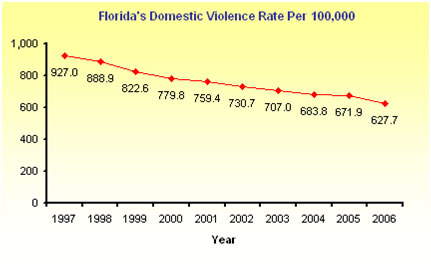 |
Statistics about IPV/DV vary widely for
a number of reasons. It is estimated that cases of IPV/DV
are highly underreported, so that the statistics do not reflect
the actual occurrence. Additionally, the numbers vary widely
because of differences between states on the definition of
IPV/DV, differences in how other data sources define IPV/DV
and variations in how data is collected.
IPV/DV is one of the most chronically underreported
crimes (NCADV, 2007). Only approximately one-quarter of all
physical assaults, one-fifth of all rapes, and one-half of
all stalkings perpetuated against females by intimate partners
are reported to the police (NCADV, 2007). Even fewer IPV/DV
incidents against men are reported. The reported data greatly
underestimates the true magnitude of the problem.
The following represents national
information on the occurrence of IPV/DV. In many cases, the
severity of the IPV/DV behaviors is not known and because
of the differences in the definitions of IPV/DV and how statistics
are gathered, there are discrepancies in the statistics.
- An estimated 1.3 million women are victims of physical
assault by an intimate partner each year (NCADV, 2007a).
- 85% of domestic violence victims are women (NCADV, 2007a).
- Historically, females have been most often victimized
by someone they knew (NCADV, 2007a).
- Females who are 20-24 years of age are at the greatest
risk of nonfatal intimate partner violence (NCADV, 2007a).
- Most cases of IPV/DV are never reported to the police
(NCADV, 2007a).
- Almost one-third of female homicide victims that are reported
in police records are killed by an intimate partner (NCADV,
2007a).
- In 70-80% of intimate partner homicides, no matter which
partner was killed, the man physically abused the woman
before the murder (NCADV, 2007a).
- One in 6 women and 1 in 33 men have experienced an attempted
or completed rape (NCADV, 2007a).
- Nearly 7.8 million women have been raped by an intimate
partner at some point in their lives (NCADV, 2007a).
- Sexual assault or forced sex occurs in approximately
40-45% of battering relationships (NCADV, 2007a).
- 1 in 12 women and 1 in 45 men have been stalked in their
lifetime (NCADV, 2007a)
- 81% of women stalked by a current or former intimate partner
are also physically assaulted by that partner; 31% are also
sexually assaulted by that partner (NCADV, 2007a).
- Each year, women experience about 4.8 million intimate
partner related physical assaults and rapes (CDC, 2006).
- Men are the victims of about 2.9 million intimate partner
related physical assaults (CDC, 2006).
- IPV/DV resulted in 1,544 deaths in 2004. Of these deaths,
25% were males and 75% were females (CDC, 2006).
- Between 4% and 8% of pregnant women are abused at least
once during the pregnancy (Gazmararian, et al., 2000).
- Prevalence of IPV/DV varies among race. Among the ethnic
groups most at risk are American Indian/Alaskan Native women
and men, African-American women, and Hispanic women (Tjaden
& Thoennes, 2000b).
- Young women and those below the poverty line are disproportionately
victims of IPV/DV (Tjaden & Thoennes, 2000b).
Statistics specifically for Florida include:
- In 2007, there were 115,150 reported domestic violence
incidents (FDLE, 2008).
- Females were the victims in 85% of domestic violence homicides
in 2007 (NCADV, n.d.).
- Of the 115,150 reports, there were 114 deaths, which included
189 cases of homicide, which was 25 more than in 2006 (NCADV,
n.d.) and 25 cases of manslaughter (FDLE, 2008).
- Miami Dade county had the highest number of deaths that
year with 23 cases of homicide related to IPV/DV, followed
by Pinellas and Broward counties with 15 homicides each
(FDLE, 2008).
- The most common charge in domestic violence cases was
for aggravated assault; there were 19,629 cases of aggravated
assault. There were also 89,381 cases of simple assault
(FDLE, 2008).
- 24% of all aggravated assaults in 2007 were domestic
violence related (NCADV, n.d.).
- There were 6,145 forcible rapes, 1,402 cases of forcible
sodomy and 3,667 cases of forcible fondling reported in
Florida in 2006 (NCADV, n.d.).
- In 2007 there were 400 reports of stalking (FDLE, 2008).
- Of the victims of domestic violence, 27,785 were the
spouse of the abuser, 33,894 victims cohabited with the
abuser, and 9,017 were the children of the abused (FDLE,
2008);
- Of the reported cases, 66% of the offenses were committed
by a spouse, co-habitant, or girlfriend/boyfriend (NCADV,
n.d.).
Figure 1. National Coalition Against Domestic Violence:
Florida's Rate 1997-2006

Overall, the rate of domestic violence in Florida has declined
since 1997 (see Figure 1), reflecting the national trend of
slowly declining rates of IPV/DV. While that indicates an
improvement, the suffering for those who continue to be abused
persists.
Continue on to
|
 |